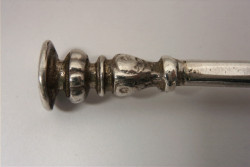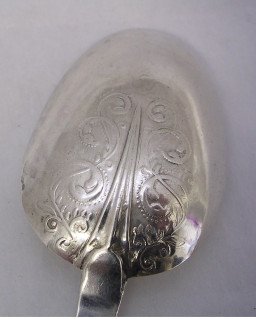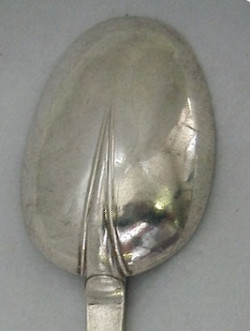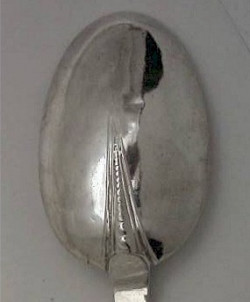Apostle Spoon
Undoubtedly the most well known and easily recognised of all the antique spoons, with its diagnostic figural finial, is the apostle spoon. The ideal set of apostle spoons, numbers thirteen, and includes the Master (i.e. Jesus). The other twelve are of varying rareness and are as follows; St. Andrew, St. Bartholomew, St. James The Greater, St. James The Less, St. John, St. Jude, St. Matthias, St. Matthew, St Peter, St. Philip, St. Simon Zelotes and St. Thomas. Although not one of the original apostles, St Paul is also depicted and each apostle is recognised by the emblem he is carrying. St Paul and St. James are the most frequently encountered, probably due to St. Paul being the patron saint of London, and the popularity of the latter being given as a christening gift to children.

The apostle spoon dates from the 15th Century, possibly even as early as the 14th Century, and continued to be made in large numbers until the mid 17th Century. On top of each apostle (except on particularly early examples and provincial examples) is a nimbus, i.e. a round halo or disc, often pierced or impressed with a depiction of the sacred dove. The evolution of apostle spoons through the centuries is a study in itself, and the appropriate books should be referred to.
Forgeries are common, but most are easy to spot. The most common fake is the conversion of an 18th century table spoon. These will have the usual four hallmarks along the bowl end of the shank with no bowl mark. If you are able to read the date letter as 18th century or ascribe the maker to the 18th century, then it is a fake: apostle spoons were never made in the 18th century and London examples do not carry four marks on the stem. These were standard Old English or Hanoverian pattern table spoons that were re-worked and fitted with an apostle.
Our stock of apostle spoons can be found in the Early Spoons section of the shop.
Seal Top Spoon
The seal top is the most commonly found type of spoon from the 16th and 17th Centuries. The finial is in the form of a column and can vary in length and design, but always with a flat disc at the end in the form of a seal, but they were never intended to have this dual purpose. As with apostle spoons, this form was not made during the 18th century and so any spoon found with 18th century hallmarks will be a table spoon conversion and should be considered as fakes.

We always maintain a stock of London and provincially made seal top spoons and these can be found in the Early Spoons section of the shop.
Slip Top Spoon
 Generally considered to be an early to mid 17th Century spoon, however they do occur from the previous century. They are very simple in design with a hexagonal stem with the end cut off at an angle. The placing of the hallmarks is generally characteristic with three marks placed at the bowl end of the stem, and the date letter sited near the slip end (provincial examples differ).
Generally considered to be an early to mid 17th Century spoon, however they do occur from the previous century. They are very simple in design with a hexagonal stem with the end cut off at an angle. The placing of the hallmarks is generally characteristic with three marks placed at the bowl end of the stem, and the date letter sited near the slip end (provincial examples differ).
Puritan Spoon
A very plain spoon, particular favoured during the Commonwealth period, and owing to this short span of production in the 17th Century, tends to be quite rare. Provincial examples tend to be more common than London specimens. They were the first style of spoon to have a flat stem, previously hexagonal was the standard form. The stem is plank-like and ends without decoration, the bowl shape changed to almost oval, and in later examples the first appearance of a small rat-tail under the bowl is noted, to improve the strength of the join between stem and bowl.
Trefid Spoon (Trifid)

Dating from the post Commonwealth period, circa 1660, the Trefid spoon appears in many different forms, but always has a flat stem and the diagnostic terminal where the stem is divided into three sections. In the period between 1660 and 1700, when the Trefid was superseded by the dog-nose spoon, a multitude of variations occurred.
The most sought after are the lace-backs and flame-backs, generally dating from the years around the 1680's. The lace-backs have intricate chasing to the reverse of the bowl, and occasionally to the front stem terminal. The flame-backs have very ornate all over engraving often obliterating the hallmarks.

Variations in the three lobed terminal, and the decoration around the rat-tail to the reverse of the bowl (e.g. beaded rat tails, and reeded rat tails), are also sought after.

Reeded rattail Trefid 1690

Beaded rattail Trefid 1699
Dog-nose Spoon (Wavy-end)
The successor to the Trefid at the end of the 17th Century was the dog-nose spoon.
 It has a very distinctive shape with a shaped, rounded terminal, always has a long rat-tail to the reverse of the bowl (occasionally decorated). Its span of production, circa 1690 to 1715, coincides with the period in English silver where the Britannia Standard(95.8% pure) was used, hence all spoons produced at this time will carry these marks.
It has a very distinctive shape with a shaped, rounded terminal, always has a long rat-tail to the reverse of the bowl (occasionally decorated). Its span of production, circa 1690 to 1715, coincides with the period in English silver where the Britannia Standard(95.8% pure) was used, hence all spoons produced at this time will carry these marks.
Our stock of Dog Nose and Trefid Spoons can be found in the Early Spoons section of our shop.
Other Early Spoons
A number of other rarer styles of spoon existed prior to the 1660's when Trefids became the dominant pattern, for example Diamond Point, Acorn Knop and Wrythen Knop. Plus an assorted range of spoons with finials similar in style to the apostle such as Maidenhead, Buddha Knop and Lion Sejant.
Maidenhead Spoon, London 1586
Later Spoons
Following on from the Dog nose spoon, towards the end of Queen Ann's reign, came the Hanoverian rat-tail pattern. The evolution of later styles and patterns can be found in the Flatware Patterns section.
